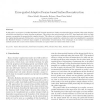Free Online Productivity Tools
i2Speak
i2Symbol
i2OCR
iTex2Img
iWeb2Print
iWeb2Shot
i2Type
iPdf2Split
iPdf2Merge
i2Bopomofo
i2Arabic
i2Style
i2Image
i2PDF
iLatex2Rtf
Sci2ools
GMP
2006
IEEE
2006
IEEE
Adaptive Fourier-Based Surface Reconstruction
In this paper, we propose to combine Kazhdan’s FFT-based approach to surface reconstruction from oriented points with adaptive subdivision and partition of unity blending techniques. This removes the main drawback of the FFT-based approach which is a high memory consumption for geometrically complex datasets. This allows us to achieve a higher reconstruction accuracy compared with the original global approach. Furthermore, our reconstruction process is guided by a global error control accomplished by computing the Hausdorff distance of selected input samples to intermediate reconstructions. The advantages of our surface reconstruction method include also a more robust surface restoration in regions where the surface folds back to itself. Key words: Surface Reconstruction, Fast Fourier Transform (FFT), Oriented Point Data, Partition of Unity
| Added | 11 Jun 2010 |
| Updated | 11 Jun 2010 |
| Type | Conference |
| Year | 2006 |
| Where | GMP |
| Authors | Oliver Schall, Alexander G. Belyaev, Hans-Peter Seidel |
Comments (0)

